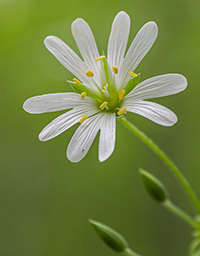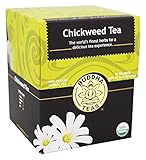Table of Contents
The humble chickweed plant is highly appreciated by birds and poultry and by those who know nature and the gifts it offers human beings. Chickweed grows small leaves from its young stems when the pastures become green in early spring. This is the right time to gather the plants and prepare tasty salads. Some people cook it like spinach. Raw or cooked, chickweed does not have a sour or hot flavor, being quite similar to cultivated vegetables in taste.
- CHICKWEED: Abundant traditional herb with naturally occurring bioflavonoid plant compounds
- TRADITIONAL FORMULA: The equivalent of 1,000 mg of Chickweed in each quick-release capsule
Chickweed was mentioned by the great Greek physician, pharmacologist, botanist, and author Pedanius Dioscorides in the 1st century A.D., though its properties were not well-known until the last century. Sebastian Kneipp, the renowned master of German natural medicine, used this plant successfully in afflictions of the respiratory airways.

Chickweed Plant Scientific Facts
- Other names: Adder’s mouth, Indian chickweed, satin flower, starwort, stitchwort, tongue-grass, winterweed.
- French: Stellaire.
- Spanish: Alsine.
- Environment: It is spread worldwide and usually grows in humid soils. Farmers consider this plant a weed in cultivated lands.
- Description: This is a plant of the Cariofilaceae family. It has weak stems, oval-shaped, peak-tipped leaves, and small star-shaped white flowers that open at noon.
- Parts of the plant used medicinally: The whole plant.

Healing Properties and Indications
The whole plant is rich in mineral salts and trace elements (especially magnesium, phosphorus, silicon, potassium, iron, and copper), as well as in B vitamins and vitamin C. Chickweed also contains a certain amount of saponins (from the Greek saponem, soap), which are substances that decrease the surface tension of water, producing foam-like soap. In the mucous membranes of the body, the saponins cause the formation of a fine, long-lasting foam.
The saponins are the most important active components of chickweed. Most of the properties of this plant are due to these substances.

- Expectorant: It eliminates dry or thick secretions in bronchitis and simple bronchial catarrh.
- Emollient: It is used with gastritis to protect the stomach mucous membrane and alleviate the heavy sensation associated with this disorder. With colitis (inflammation of the large intestine), it is used to favor a regular, painless evacuation since it has a mild laxative effect.
- In external applications, chickweed eliminates the skin inflammation caused by bruises, irritations caused by physical reasons (sunburns, etc.), or chemical ones (toxic substances, etc.).
- Invigorating: Due to its mineral salts and vitamins content, chickweed naturally stimulates the whole body, producing a sense of well-being and vitality. It is beneficial for fatigue or exhaustion.
This plant is a common weed that is very valuable for treating fevers, blood toxicity, inflammations, and other “hot” diseases. Chickweed is known to relieve nasal congestion. It is helpful for hoarseness, skin diseases, coughs, colds, bowel inflammation, circulatory problems, pleurisy, and bronchitis. This herb is mild, as safe as any garden vegetable, and contains vitamins and minerals. Most people usually eat it as a salad green. Therefore, it is okay to use in high dosages.
Chickweed lowers blood lipids, so it is beneficial in reducing excess fat thanks to its mild laxative and diuretic properties. Drinking its tea helps to build blood. The plant can also be applied as a poultice to abscesses, boils, and warts. It can also be used for various skin diseases and sores when made into an oil and ointment.
Adding chickweed plant tea to a bath helps soothe skin irritations and rashes. It is also used as a salve for itchy and dry skin, and it is also used for mouth sores. In Europe, it is used as a cooling expectorant and demulcent to relieve coughs, skin diseases, and itching.
How to use Chickweed
- Raw in salads or cooked like spinach.
- Decoction
- Poultices
Infusion: Steep for five to fifteen minutes. Take 6 ounces three to four times daily between meals. Decoction: One ounce to 1 ½ pint boiling water, simmered to one pint. Take three ounces three to four times every two to three hours when needed. Tincture: Take ½ teaspoon as needed. Fluid Extract: Take ½ to one teaspoon as needed. Powder: Take five to ten #0 capsules (30 to 60 grains) thrice daily.
Frequently Asked Questions
What are the main compounds in the chickweed plant responsible for potential benefits?
1. Flavonoids: Rutin and quercetin are known for antioxidant and anti-inflammatory effects.
2. Saponins: May have mild expectorant (helps clear mucus) and diuretic properties.
3. Vitamins and Minerals: Contains vitamin C, potassium, magnesium, and others, though amounts vary based on growing conditions.
Are there studies supporting the chickweed plant’s use for skin conditions?
While traditional use is extensive, modern studies are limited. Some test-tube research suggests anti-inflammatory and potential wound-healing properties.
Can the chickweed plant help with weight loss or management?
Limited animal studies suggest a potential effect on fat absorption and appetite, but this has NOT been replicated in humans. Chickweed’s high fiber content and low-calorie count could be a beneficial component of a well-rounded diet. Still, it is not a remedy for weight loss. Chickweed’s high fiber content and low-calorie count could be a beneficial component of a well-rounded diet.
Has the chickweed plant proven beneficial against specific diseases?
No. Chickweed is promising in early lab studies (anti-viral, regulating blood sugar). Still, large-scale human trials are necessary before recommending it for disease treatment.
Is fresh chickweed better than supplements (teas, capsules, etc.)?
It depends on your goal. Fresh chickweed offers the most nutrients, but supplements provide standardized dosing. If using fresh, ensure correct identification and wash thoroughly since it’s a common lawn weed.
Can chickweed interact with medications?
There are insufficient data on potential interactions. Due to its possible blood sugar-lowering effects, use caution on diabetes medications. Always consult your doctor before combining herbal remedies with prescriptions.
Are there any known safety concerns with chickweed?
It is generally considered safe in typical amounts. Some individuals may experience mild digestive upset. Avoid if you are pregnant or breastfeeding, as safety is unestablished in these groups.
How do I incorporate the chickweed plant into my diet?
You can consume young leaves and shoots either raw in salads or cooked similarly to spinach.
Make an herbal tea by steeping fresh or dried chickweed in hot water. Topical application of a poultice or diluted tea for skin is traditional, but exercise caution if you have sensitive skin.
Does chickweed help with coughs or congestion?
The chickweed plant’s expectorant effects are anecdotal. It’s unlikely harmful, but don’t rely on it as a primary treatment for serious respiratory issues.
Where can I find reliable research on chickweed?
PubMed https://pubmed.ncbi.nlm.nih.gov/)
Google Scholar https://scholar.google.com/
Sites of Reputable Institutions https://examine.com/
Mayo Clinic https://www.mayoclinic.org/
DISCLAIMER: All content on this website is presented solely for educational and informational objectives. Do not rely on the information provided as a replacement for advice, diagnosis, or treatment from a qualified medical expert. If you are pregnant, nursing, or have any preexisting medical concerns, talk to your doctor before using any herbal or natural medicines.
REFERENCES
- George D. Pamplona-Roger, M.D. “Encyclopedia of Medicinal Plants.” George D. Pamplona-Roger, M.D. Encyclopedia of Medicinal Plants. Ed. Francesc X. Gelabert. Vols. 1 San Fernando de Henares: Editorial Safeliz, 2000. 334, 335. Print. [chickweed plant]
- Vance Ferrell Harold M. Cherne, M.D. The Natural Remedies Encyclopedia [Book]. – Altamont, TN: Harvestime Books, 2010. – Vol. Seventh Edition: 7: pp. 152.
- https://www.healthline.com/nutrition/chickweed-benefits
- https://www.rxlist.com/supplements/chickweed.htm
- https://www.webmd.com/vitamins/ai/ingredientmono-622/chickweed
- https://www.verywellhealth.com/chickweed-what-should-i-know-about-it-89437
Last update on 2024-07-23 / Affiliate links / Images from Amazon Product Advertising API






